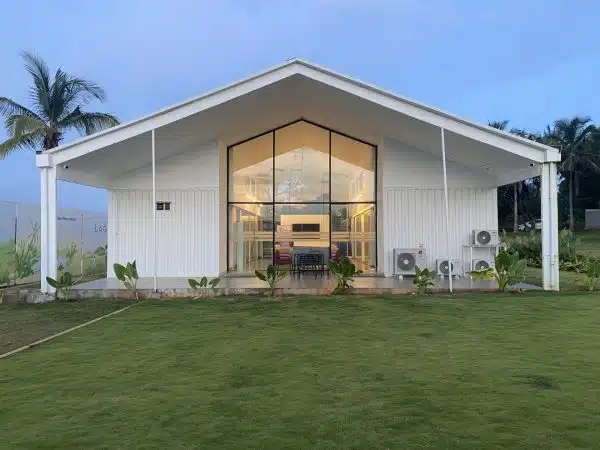Container Office Design 2025: Smart Layouts, Interiors, HVAC and ROI Insights
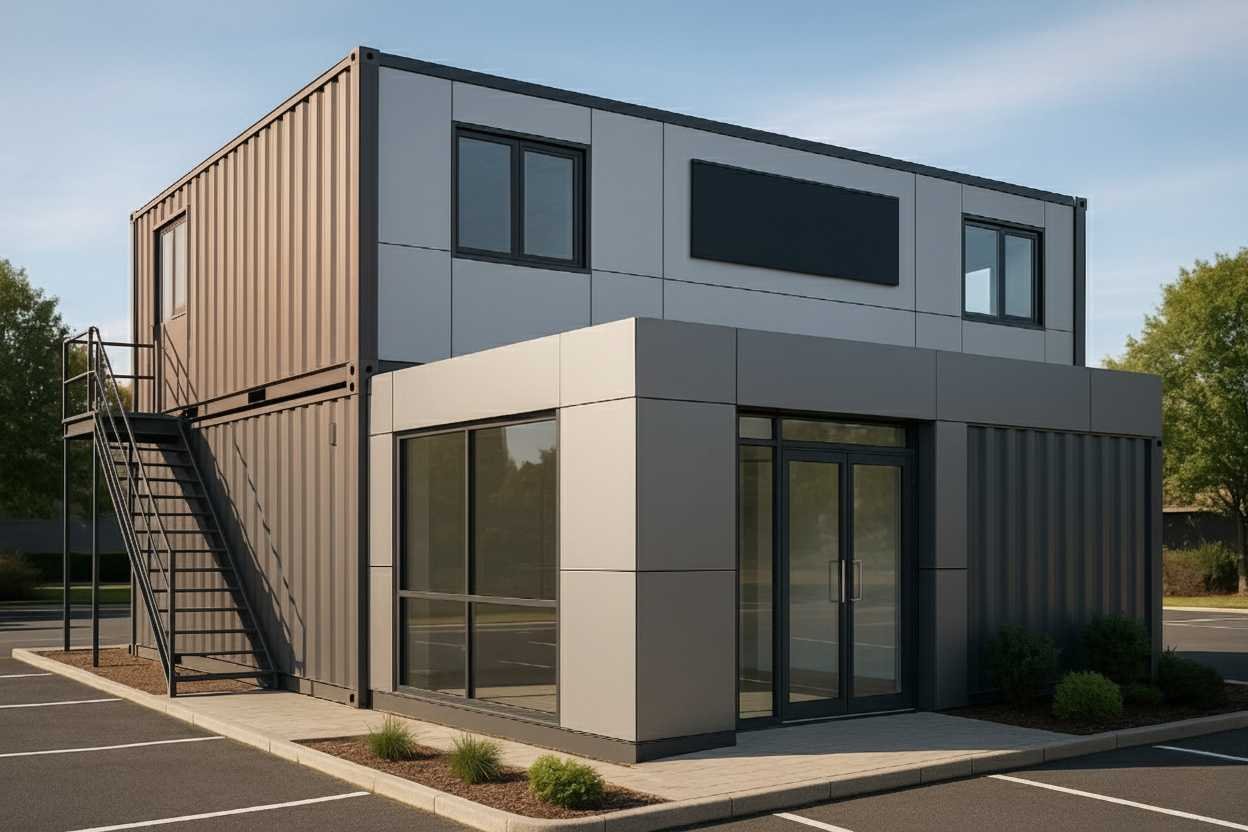
Comprehensive Introduction & Fundamentals of Container Office Design
Container office design has evolved from a quick fix into a proven workplace strategy. In 2025, companies across construction, real estate, IT, education, healthcare, and events choose modular container offices because they deliver more value in less time. They’re 70–80% cheaper than permanent builds, install in under a week, and move as projects shift. From luxury sales suites in Mumbai to co-working hubs in New York, container office design now blends speed, flexibility, eco-performance, and measurable ROI.
At Saman Portable, we specialize in modular and prefabricated solutions that blend speed with sustainability
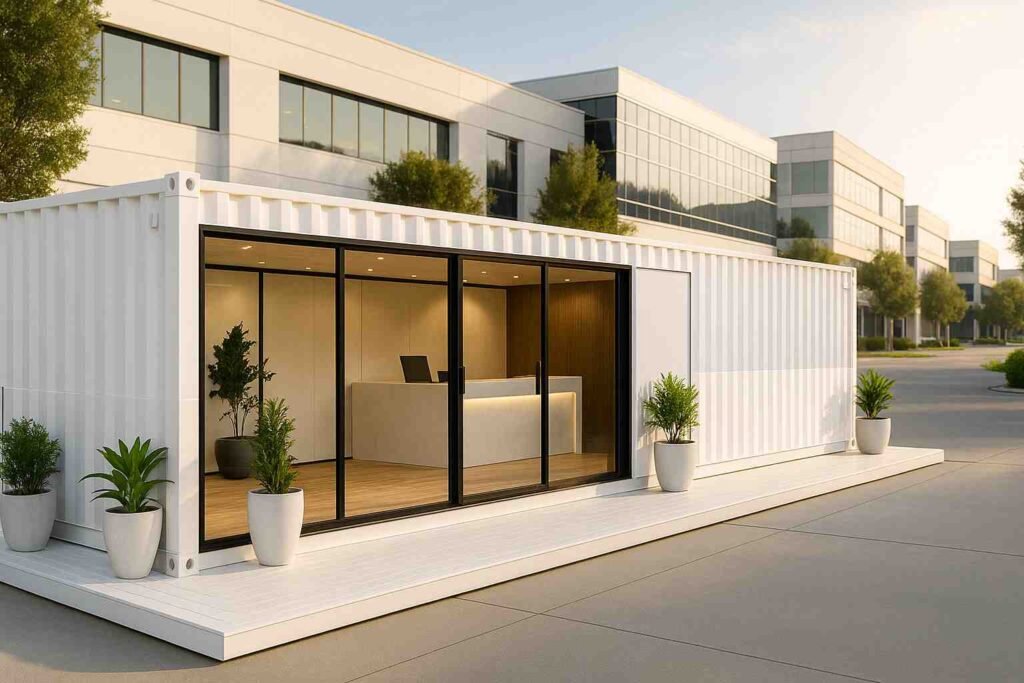
Container Office Design: The Smart Shift Redefining Modern Workspaces
Traditional builds are costly and slow. They lock teams into rigid timelines and sunk costs. Container office design flips that script. Units are delivered in days, scaled or stacked as teams grow, and moved between sites without waste. Brands can add ACP cladding, glass façades, and signage for premium presence. The result is a modern container office that protects budgets, accelerates launch dates, and keeps options open.
Market momentum is clear. Analysts project steady growth (≈7% CAGR to 2033) as sustainability targets, hybrid work, and infrastructure pipelines expand across APAC, North America, and Europe. India is scaling fastest: luxury sales suites in Mumbai, metro-project offices across Delhi NCR, and stacked IT hubs in Bengaluru, Hyderabad, and Pune. Together, these examples show container office design has matured from an experiment into an enterprise-grade solution.
Market clarification: Different reports size this market differently—some track only converted ISO containers; others include wider prefab offices. Both show steady growth and rising enterprise adoption. For credibility, cite method (ISO-only vs. broader modular) when quoting numbers.
This article introduces container office design fundamentals, explains core principles, and describes popular variations. It also presents Indian and global case studies showing the impact of design decisions on long-term performance. Readers will see why strong fundamentals make or break container office projects.
Explore our container office designs to see practical layouts and modern finishes.”
What Exactly Is Container Office Design and Why It Matters
Container office design converts ISO shipping containers into complete, code-ready workplaces. Teams plan layouts, insulation, HVAC, power, data, interiors, and exterior branding as an integrated system. Done right, a modular container office matches conventional comfort and safety standards while costing far less and deploying much faster.
Adaptability drives value. A 20-foot unit suits guard cabins or two-person teams; a 40-foot module supports full squads with meeting space. Join or stack modules to add floors, corridors, lounges, and storage. That’s why container office design works for construction HQs, classrooms, clinics, co-working, and field labs. Scale up, relocate, or repurpose—without rebuilding from scratch.
Core Principles That Make Container Office Design Work
| Principle | Why It Matters |
| Space Optimization | Containers are narrow. Layouts, modular furniture, and smart storage maximize efficiency. |
| Flexibility | Units are modular and relocatable. Offices can expand or move as business needs change. |
| Sustainability | Reused containers save steel. Insulation and solar upgrades reduce costs and carbon footprint. |
These three principles are the foundation of every successful container office project. Without insulation, offices fail under extreme climates. Poor layouts make staff unproductive. Ignoring sustainability reduces resale value and increases long-term expenses.
Indian Case Study: In Rajasthan, contractors used uninsulated containers during peak summer. Temperatures soared, and staff abandoned the cabins. By contrast, a Bangalore IT company designed insulated, air-conditioned modular offices with ergonomic furniture. Staff productivity rose, and after three years, the units were resold for 60% of their value.
Global Case Study: In Western Australia, mining companies installed insulated container labs in remote deserts. The offices endured storms, heatwaves, and dust, protecting staff and equipment. Fundamentals like insulation and flexibility determined project success.
Popular Variations of Container Office Design
| Variation | Description | Example Use Case |
| Modular Container Office | Multiple containers joined or stacked. | Corporate hubs, schools, co-working spaces. |
| Custom Container Office | Tailored layouts and branded finishes. | Real estate sales suites, startups. |
| Modern Container Office | Glass façades and smart interiors. | IT firms, creative agencies. |
| Luxury Container Office | Executive cabins with premium features. | Finance companies, sales showrooms. |
| Home Office Container | Compact backyard work units. | Remote professionals, freelancers. |
Each variation meets different needs. Modular designs serve large-scale campuses. Custom containers showcase branding for developers. Modern designs with glass walls attract IT firms seeking creativity. Luxury options impress high-value clients. Home office containers support the remote work trend.
Indian Example: In Mumbai, a developer built luxury container sales offices. Glass exteriors and branded designs created a professional image, leading to higher client trust and faster sales. Global Example: In New York, a co-working hub was built with containers featuring rooftop gardens and sustainable interiors. Memberships sold out quickly. These stories show how variations allow container office design to adapt worldwide.
Why Strong Fundamentals Decide Project Success
Strong fundamentals directly influence ROI, durability, and comfort. Projects ignoring basics often fail. Poor ventilation creates unsafe workspaces. Narrow layouts cause overcrowding. Weak foundations reduce stability. Businesses prioritizing fundamentals, on the other hand, achieve better performance.
Case Study: A Singapore finance firm constructed a three-story modular container office. Completed in weeks, the project cost 40% less than leasing permanent space. Staff reported comfort due to insulation, HVAC, and ergonomic furniture. In Delhi Metro projects, portable container offices were moved alongside construction, saving months in delays. Fundamentals like space, flexibility, and sustainability turned these projects into success stories.
Practical Pros and Cons of Container Office Design
Container office design offers powerful advantages. Cost savings are significant, often reducing expenses by 70–80% compared to traditional offices. Projects that once took months can now start within a week. Portability allows businesses to relocate offices easily, ideal for industries with mobile operations. Resale value further adds strength, with 30–50% of costs recovered.
Yet there are challenges. The standard 8-foot width limits space. Placement requires cranes, adding logistics costs. Municipal permits vary, causing delays. However, these challenges can be managed. Combining multiple units resolves space issues. Planning approvals early avoids delays. Partnering with experienced suppliers ensures compliance. When handled wisely, the pros far outweigh the cons.
The Future Potential of Container Office Fundamentals
Looking ahead, container office fundamentals will shape workplace design globally. Remote work increases demand for home office containers. Hybrid workplaces will favor modular complexes. Governments are promoting green construction, rewarding sustainable designs. Businesses investing in fundamentals now secure long-term advantages.
This section confirms that container office design delivers value through strong principles and smart variations. By applying fundamentals, businesses achieve ROI, comfort, and adaptability. Container office design is not only a solution for today—it is the future of modern work.
Key takeaways
• Container office design compresses timelines and CAPEX.
• Layouts and interiors drive comfort, brand, and ROI.
• Early approvals and accurate MEP save rework later.
According to Grand View Research, the modular construction market is expanding rapidly, reinforcing why container offices are a future-ready choice.
Benefits, Guide, Layouts & Interiors of Container Office Design
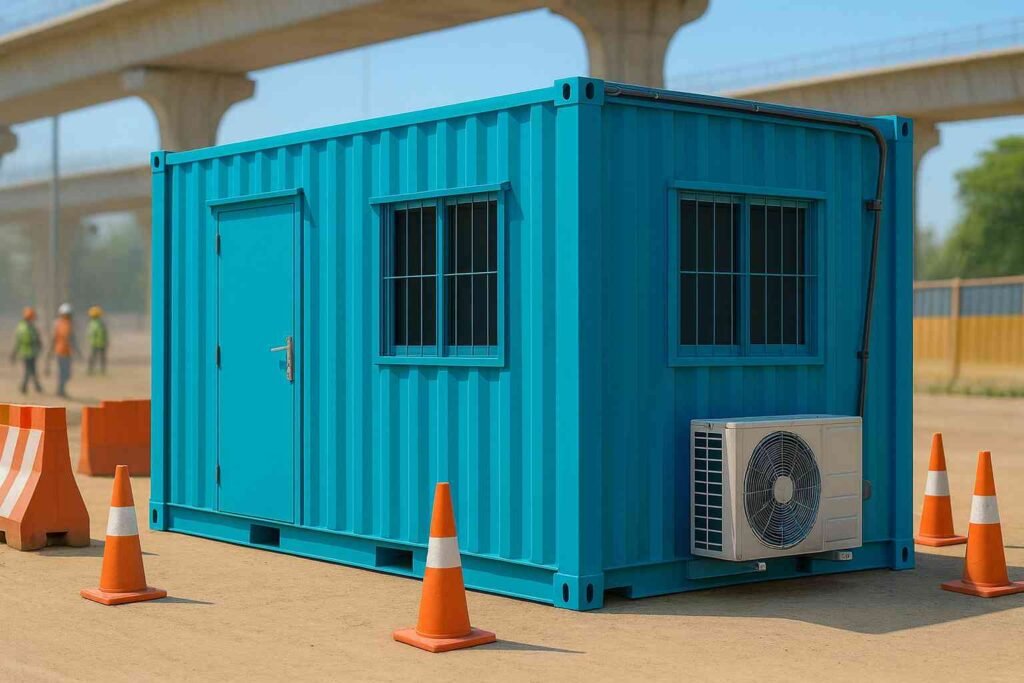
Benefits of Container Office Design: Why Businesses Prefer It
Container office design delivers speed, savings, and sustainability in one package. Projects that take six to twelve months with conventional builds can go live in a week. For infra, mining, events, and fast-growing teams, that time gain pulls revenue forward and reduces site overheads. The result: a modern container office that is affordable on day one and efficient to operate for years.
Costs are where container office design shines. While brick-and-mortar in India often exceeds ₹15,000/sq ft, engineered container offices average roughly ₹1,050–₹2,500/sq ft. That 70–80% delta funds technology, branding, and comfort upgrades. Resale matters, too—well-kept units commonly recover 30–50% of CAPEX, which permanent builds rarely achieve.
Sustainability makes container offices a preferred choice in modern corporate strategy. Each reused container saves 2.5 tons of steel. With insulation, energy use drops by 20–30%. Adding solar panels, rainwater harvesting, and LED lighting further strengthens eco-credentials. Green certifications such as LEED and GRIHA become easier to achieve, enhancing brand reputation.
Portability sets container office design apart. Offices can be relocated by truck or crane, making them ideal for construction projects, events, and remote industries. This adaptability prevents the need for repeated investment as sites change.
Indian Case Study: During the Mumbai Metro expansion, contractors deployed 20-foot container offices at different phases of construction. The units were relocated as the project advanced, cutting downtime and avoiding new site setup costs. Global Case Study: In Singapore, a finance company used a three-story modular container office as its interim headquarters. The project was finished in under six weeks, saving 40% compared to leased space while offering branded, luxury interiors.
For smaller setups, our portable cabins deliver similar flexibility with compact sizing.”
Key Benefits of Container Office Design
| Benefit | Expanded Explanation |
| Cost Savings | Up to 80% cheaper than traditional builds. Resale adds 30–50% recovery. Indian real estate firms save crores annually with container offices. |
| Speed | 1–7 days setup vs months for permanent offices. Events, healthcare, and infrastructure projects benefit most. |
| Sustainability | Reuse of containers reduces waste. Insulation, solar, and water systems cut utility bills and carbon footprint. |
| Portability | Relocation reduces reinvestment. Mining and metro projects save significant costs when shifting offices. |
| Customization | Flexible layouts, branding, smart tech, and executive finishes suit multiple industries. |
These benefits show how container office design aligns with both financial and sustainability goals. Unlike traditional construction, which locks companies into fixed costs and locations, container offices offer flexibility and measurable ROI.
ROI Comparisons of Container Office Design
Return on investment (ROI) is where container office design outshines alternatives. A Bangalore contractor invested ₹60 lakh in modular container offices. They used them for three years across projects and resold them for ₹25 lakh. The effective cost was under ₹12 lakh annually. Renting equivalent offices would have cost over ₹20 lakh per year.
In the global market, case studies reveal similar savings. A U.S. event company built a temporary headquarters from containers for $200,000. After two years, they sold it for $100,000, recovering half the cost. Renting equivalent space in New York would have exceeded $600,000. Such comparisons highlight the long-term value of container office design.
For a detailed breakdown, check our container offices price guide.
Step-by-Step Guide to Designing Your Container Office
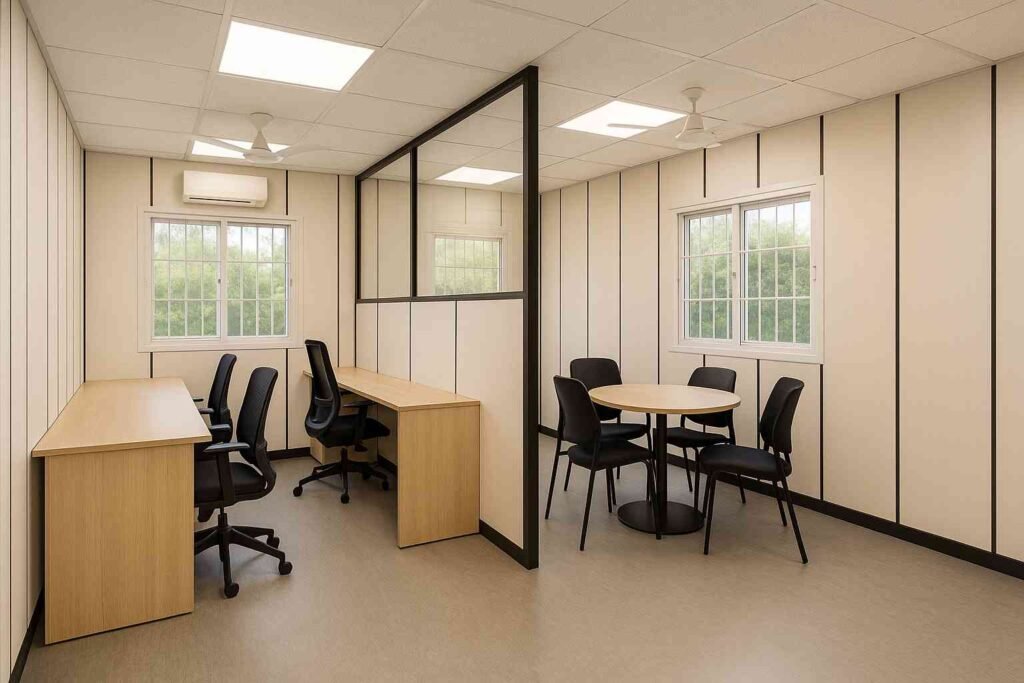
Designing a container office works best as four steps:
Step 1 — Define Use: Decide if it’s for project control, sales, co-working, or executive use. (Delhi example: branded sales suite with lounge, glass, and signage.)
Step 2 — Size & Condition: Pick 20- or 40-foot units; new for longevity, used to save upfront, refurbished as a middle path.
Step 3 — Zoning & Flow: Choose open plan vs. partitions; plan corridors, storage walls, and daylight. (Hyderabad example: expandable modules as staff doubled.)
Step 4 — Visualize & Approve: Lock designs with 3D/CAD, confirm MEP, and fast-track approvals. (Germany example: stacked labs and classrooms.)
Layouts and Space Planning in Container Office Design
Layouts decide productivity. Single-unit plans support 1–4 people with storage walls and a compact meeting nook. Multi-container complexes add meeting rooms, cafés, and training space. Expandable modules triple usable area for events and outreach. Partitioned layouts create executive cabins and silent rooms while keeping a collaborative core.
Indian Case Study: A Pune contractor used a single 20-foot unit as a safety office, operational in 24 hours. Global Case Study: In New York, a co-working hub stacked containers with lounges, Wi-Fi, and gardens. Startups flocked to it as an affordable alternative.
Ergonomics matter. Built-in desks, modular chairs, and wall storage optimize compact areas. Lighting design also improves productivity. Placing desks near windows provides daylight. LED systems cut electricity bills.
See more options in our types of container offices guide
Layout Options in Container Office Design
| Layout Type | Description | Example Use Case |
| Single-Unit Layout | Compact setup for 1–2 users. | Site managers, guard cabins. |
| Multi-Container Complex | Joined or stacked containers. | IT hubs, training centers. |
| Expandable Container | Units unfold to add space. | Healthcare camps, events. |
| Partitioned Layout | Divides zones for privacy. | Sales offices, executive suites. |
These layout options provide flexibility. Businesses can start small and scale up. Events and healthcare providers prefer expandable units. Corporate firms value partitioned layouts for professionalism.
Interior Design & Finishes That Enhance Productivity
Interiors transform containers into appealing workplaces. Furnished options come with desks, AC, and lighting. Executive versions add premium flooring, glass partitions, and ergonomic furniture. Smart technology further improves comfort. Motion-sensor lights reduce bills. Biometric locks enhance security. Wi-Fi mesh ensures connectivity.
Color psychology impacts mood. White and beige enlarge spaces. Blue promotes calm focus. Green emphasizes eco-friendliness. Design trends show growing demand for natural wood finishes, energy-efficient systems, and branded walls.
Indian Example: In Delhi, a contractor designed a 40-foot container office with central corridors and side rooms. Staff found it easier to collaborate. Global Example: A Singapore startup integrated smart lighting and biometric entry. Energy costs fell 20%, and security improved.
Case Study: A Mumbai developer created a luxury container lounge with branded interiors, plush seating, and client-facing meeting rooms. This professional environment directly improved sales conversion rates.
Conclusion: Insights on Benefits, Guide, Layouts & Interiors
Section 2 establishes container office design as a modern, adaptable solution. Benefits like cost savings, speed, sustainability, and portability give it an edge. A step-by-step approach ensures smooth implementation. Layout options provide flexibility for industries from construction to IT. Interiors add comfort, professionalism, and branding power. With strong design and planning, container office design secures high ROI and global relevance.
Key takeaways
• Container office design compresses timelines and CAPEX.
• Layouts and interiors drive comfort, brand, and ROI.
• Early approvals and accurate MEP save rework later.
Final Expanded HVAC, Exteriors & Smart Features in Container Office Design
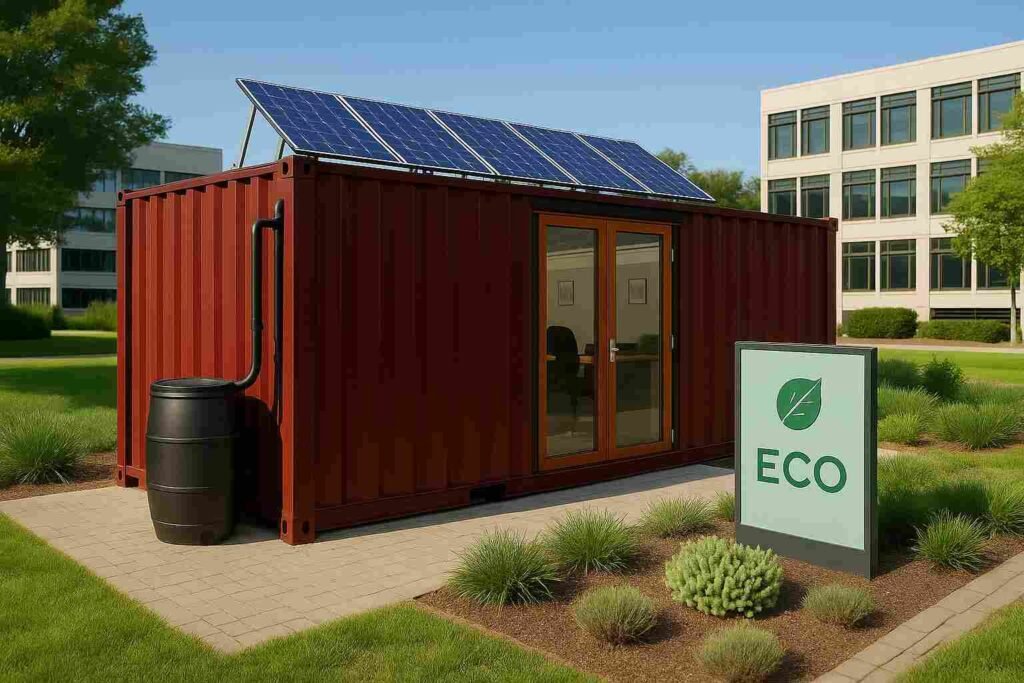
HVAC and Climate Control in Container Office Design
Steel conducts heat and cold fast, so climate control is non-negotiable in container office design. Insulation plus the right HVAC keeps interiors stable across seasons, protects equipment, and lowers operating costs worldwide.
Insulation is the foundation. Options include PUF panels, rock wool, spray foam, and double glazing. These cut temperature swings, improve soundproofing, and lower energy costs by 20–30%. HVAC solutions depend on office size. Small modular container offices rely on split AC, while larger modern complexes use VRF systems with zone control. Luxury container offices often integrate double-glazing with centralized climate systems.
Indian Comparisons: Delhi’s 45°C summers require strong insulation with VRF cooling. Bangalore’s moderate climate allows cost-effective split AC units. In Mumbai, monsoon-ready insulation and anti-rust coatings are critical. Global Comparisons: Middle Eastern container offices require high-capacity HVAC to handle desert heat. In Europe, design focuses on retaining warmth through insulation and double glazing.
Insulation and HVAC Solutions for Modular and Luxury Container Offices
| Solution | Description | Best Fit |
| PUF Panels | Thermal resistance, energy-efficient. | Hot regions like Delhi, Hyderabad. |
| Rock Wool | Fire and sound resistant. | Industrial modular offices. |
| Spray Foam | Cost-friendly air sealing. | Temporary or small offices. |
| Double Glazing | Extra noise and thermal control. | Luxury container offices. |
| Split AC | Compact cooling system. | Small modular offices. |
| VRF System | Zone-based control for comfort. | Corporate campuses, IT hubs. |
| External HVAC | High-capacity for clusters. | Healthcare and large modular complexes. |
This table summarizes HVAC and insulation options. Choosing the right system ensures comfort, reduces energy bills, and adds resale value to container office design projects.
Exterior Finishes and Branding in Container Office Design
Exterior finishes carry the first impression and protect the asset. ACP cladding, powder-coated steel, timber accents, glass façades, vinyl wraps, and green walls improve durability, thermal comfort, and brand presence—turning the office into a high-impact billboard.
Steel panels are tough and low-maintenance. ACP cladding gives a sleek corporate identity. Timber panels appeal to eco-conscious clients. Glass façades enhance luxury branding. Vertical gardens improve insulation and sustainability. Vinyl wraps allow creative marketing.
Indian Case Study: A Mumbai developer built luxury container offices with ACP and glass. Sales conversions rose as clients trusted the modern image. Global Case Study: In Singapore, a co-working hub installed vertical gardens. This eco-branding strategy cut cooling bills by 15% and attracted green-minded tenants.
Exterior Finish and Branding Options for Modern Container Offices
| Finish Option | Advantages | Best Use Case |
| Steel Panels | Durable and affordable. | Industrial modular offices. |
| ACP Cladding | Modern, sleek identity. | Corporate and sales offices. |
| Glass Façades | Premium and open feel. | Luxury container office design. |
| Timber Panels | Eco-friendly and warm. | Green projects, eco-branding. |
| Vinyl Wraps | Customizable for marketing. | Branded modular container offices. |
| Vertical Gardens | Insulation and branding. | Eco-conscious modern offices. |
Exterior finishes influence ROI. A modular container office with ACP branding resells faster than plain steel cabins. Luxury container offices with glass façades attract higher-paying clients. Branding directly impacts sales and perception.
Smart Features in Modern Container Office Design
Smart features move container office design beyond shelter. IoT sensors, AI-assisted layouts, access control, CCTV, and renewables turn modular offices into secure, efficient, always-connected hubs.
IoT sensors automate HVAC and lighting, saving 15–20% on bills. Smart locks, RFID, and biometric systems improve safety. AI-driven design optimizes window placement and airflow. AR tools allow clients to preview interiors before construction. Solar panels and inverters provide backup power, making container offices sustainable.
Indian Example: A Gurugram co-working hub integrated IoT lighting, biometric entry, and CCTV into modular container offices. Memberships increased because clients valued tech-enabled environments. Global Example: In Singapore, AI systems recommended window placement in a modern container office. This lowered AC usage by 18% and improved natural light.
ROI Impact of HVAC, Exteriors and Smart Features
Investments in HVAC, exteriors, and smart features directly improve ROI in container office design. A modular office with basic finishes may save money upfront, but resale value is lower. Adding ACP cladding, insulation, and smart lighting increases resale recovery by 15–20%.
Case Study: A Bangalore IT firm spent ₹30 lakh on modular container offices with insulation and branded exteriors. After three years of use, they resold units for ₹18 lakh, recovering 60%. By comparison, a plain uninsulated office would have sold for only 40% of cost.
Global Study: A U.S. event company invested in smart container offices with solar and Wi-Fi. Resale was 35% higher than plain units. Technology and branding create lasting value beyond first use.
Industry-Specific Applications of HVAC, Exteriors and Technology
Different industries benefit uniquely from HVAC, exteriors, and smart features in container office design:
Education: Schools use modular offices as classrooms. Insulation and AC ensure comfort for students, while branding highlights institutional identity.
Healthcare: Expandable modular offices with HVAC become mobile clinics. Smart systems keep medicines safe, and exteriors display healthcare branding.
Events: Event firms use modular container offices with branding wraps and smart Wi-Fi hubs. HVAC ensures comfort, while exteriors double as advertising.
Mining: Mining firms deploy insulated container offices with durable steel exteriors. Smart tech like CCTV improves worker safety in remote areas.
Indian Example: A Pune school added modular classrooms with branded exteriors and AC. Students experienced better comfort and focus. Global Example: In Africa, NGOs used expandable container clinics with solar and HVAC, serving rural populations effectively.
Future Trends in HVAC, Exteriors and Smart Features
Future container office design will integrate with smart cities. AI will optimize designs automatically. Renewable energy will be mandatory in many regions. Branding will move toward digital exteriors, using LED screens instead of static signage. Sustainability and technology together will redefine what modern container office design looks like in the next decade.
Conclusion: HVAC, Branding and Technology Drive Value in Container Office Design
Section 3 shows that HVAC, exterior finishes, and technology are core elements in container office design. They ensure comfort, durability, branding, and ROI. Industry examples prove these features benefit education, healthcare, events, and mining. Future trends confirm that container office design will keep evolving, staying sustainable and tech-driven. Investing in these elements secures long-term value for businesses in India and worldwide.
Key takeaways
• Container office design compresses timelines and CAPEX.
• Layouts and interiors drive comfort, brand, and ROI.
• Early approvals and accurate MEP save rework later.
Safety, compliance, cost, and ROI are critical pillars in container office design. While modular and modern container offices deliver speed and flexibility, long-term success depends on how well they meet safety standards, legal requirements, and financial performance. In this block, we expand each dimension—safety and compliance, costs and ROI, pros and cons, and industry applications—showing how container office design serves as both a secure and profitable investment globally and in India.
Comprehensive Safety and Compliance in Container Office Design
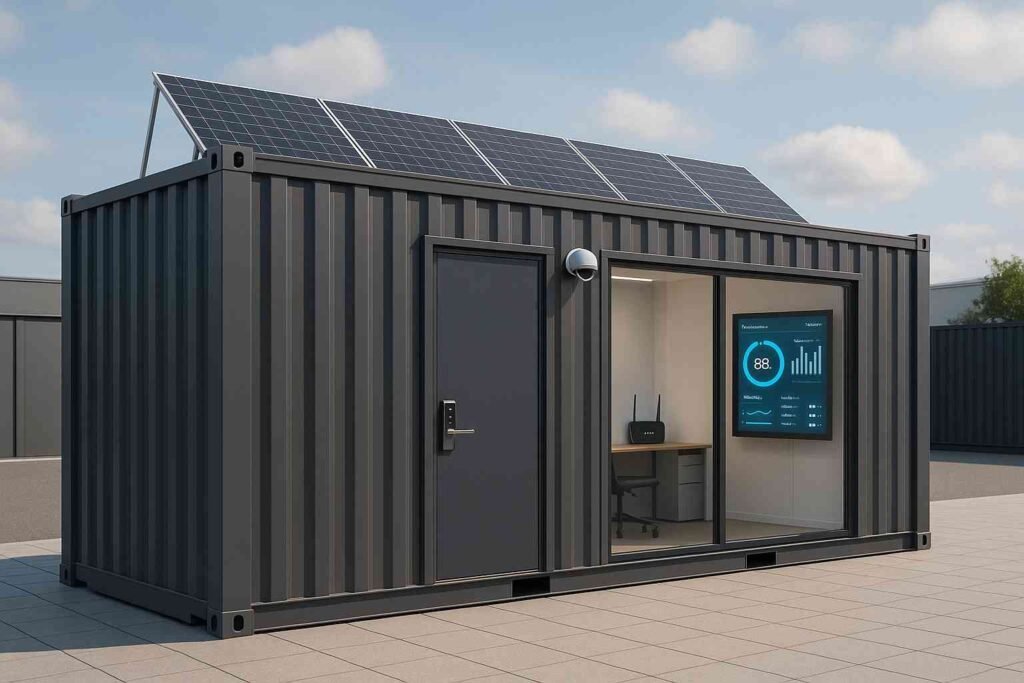
Every container office design must meet local code. In India, that means NBC for structure, fire, and accessibility; globally, OSHA/CE/ISO govern comparable areas. Skipping approvals risks stoppages, fines, and insurance issues—so plan safety systems and sign-offs first.
Detailed Example India: A contractor in Delhi attempted to launch a modular container office without securing fire permits. Within weeks, inspectors halted operations, demanding smoke alarms, fire-retardant panels, and emergency exits. The correction cost more than ₹5 lakh and delayed the project by two months.
Detailed Example Global: In London’s Docklands, the famous Container City project passed rigorous UK safety audits. It used fire-rated insulation, sprinkler systems, and structural reinforcements, setting a global benchmark for safe container office design.
Safety & Compliance Checklist for Modular and Modern Container Offices
| Requirement | Details | Impact |
| Structural Integrity | Engineer-certified stacking, load-bearing design. | Ensures safety in multi-level modular container offices. |
| Fire Systems | Detectors, alarms, extinguishers, fire-rated panels. | Reduces fire risk in steel structures. |
| Emergency Exits | Illuminated signs, wide exits, ladders for stacked units. | Protects occupants during evacuation. |
| Accessibility | Wheelchair ramps, accessible toilets, wide doors. | Meets inclusivity requirements and laws. |
| Ventilation | Cross-ventilation and air circulation standards. | Prevents suffocation and improves air quality. |
| Zoning & Land Use | Verify permitted land use. | Avoids legal fines and shutdowns. |
| Insurance | Fire, theft, transport, and liability coverage. | Protects business from unexpected losses. |
Expanding this checklist shows the multiple layers of safety container office design must address. Beyond codes, it includes practical needs like proper ventilation and insurance. A modular container office built to this standard is more resilient, safer for workers, and more attractive for clients.
Detailed Costs and ROI in Container Office Design
Cost advantages are decisive. Permanent offices often run ₹40–60 lakh in India; comparable modular container offices start near ₹2–15 lakh depending on finish and branding. Globally, typical ranges are ~$12k–$75k. Insulation and efficient HVAC then keep monthly bills in check.
Indian ROI Case: A Bengaluru IT firm invested ₹30 lakh in modular offices with ACP cladding and branded interiors. They used the offices across three projects over four years. When sold, the recovery was ₹18 lakh (60%). The effective cost of ownership was less than half compared to leasing traditional offices.
Global ROI Case: A Canadian mining company invested $250,000 in modular container offices for remote sites. Over six years, the units were redeployed multiple times, saving $400,000 compared to renting or building fixed offices.
Cost vs ROI: Container Office Design vs Alternatives
| Office Type | Initial Cost | Resale/Recovery | ROI Benefits |
| Container Office Design | ₹2–15 lakh (India) / $12k–$75k | 50–70% recovery | Fast setup, portability, strong resale. |
| Porta Cabin | ₹1.5–8 lakh | 20–30% recovery | Cheaper upfront but lower durability and resale. |
| Traditional Office | ₹40–60 lakh+ | Minimal recovery | Long timelines, high costs, low adaptability. |
This table demonstrates the superior ROI of container office design. Initial costs are low, resale is high, and the ability to reuse across projects makes modular container offices the most financially viable choice.
Pros and Cons of Container Office Design
Pros: Container office design offers unmatched affordability and speed. Projects that might take six months with traditional offices can be ready in one week. Portability allows relocation with cranes or trailers, making it ideal for mining, construction, and events. Sustainability is another pro. Each reused container saves 2.5 tons of steel and reduces carbon footprint.
Cons: Despite the advantages, challenges exist. The standard 8ft width restricts interior layouts. Municipal permit rules vary widely across Indian cities, delaying projects. Installation requires cranes, adding logistics costs. Extreme climates require high-quality insulation, raising upfront expenses. However, the resale value, ROI, and operational savings outweigh these cons.
Expanded Industry Applications of Container Office Design
Container office design proves useful across multiple industries worldwide.
Construction
Delhi Metro relied on modular offices relocated every two weeks. This reduced setup delays and kept operations agile.
Healthcare
In Rajasthan, expandable container offices became mobile clinics. They included HVAC, insulation, and branded exteriors, making rural healthcare possible.
Education
NGOs in Himachal Pradesh created modular classrooms. Insulation allowed children to study during winter snowfalls.
Events
Trade fairs in Chennai deployed branded modular offices for reception and control centers. Portable layouts enabled quick relocation.
Mining
Australian mining firms used insulated 40ft modular container offices as labs and worker stations in extreme heat.
Corporate
Gurugram hubs integrated IoT lighting and biometric locks in modern container offices, attracting startups.
NGOs
African NGOs deployed solar-powered container healthcare clinics, reaching remote areas with reliable medical services.
International Infrastructure
Dubai Expo 2020 used luxury modular container offices as command centers. After the event, units were reused as corporate showrooms.
Conclusion: Safe, Compliant and Profitable Container Office Design
Expanding safety, compliance, cost, and industry applications shows why container office design is a future-proof solution. Safety checklists protect businesses from risks. Detailed ROI analysis confirms savings in both India and global markets. Pros and cons highlight challenges, but ROI remains positive. Industry examples—from Delhi Metro to Dubai Expo—prove that container office design is safe, compliant, adaptable, and profitable for all sectors.
Key takeaways
• Container office design compresses timelines and CAPEX.
• Layouts and interiors drive comfort, brand, and ROI.
• Early approvals and accurate MEP save rework later.
Global Trends, Sustainability & Future Outlook in Container Office Design
Container office design is now mainstream. India and global markets alike are adopting modular, modern, luxury, and smart formats to hit speed, sustainability, and cost targets. This section compares India vs global trends, shows sustainability ROI, and outlines tech-led futures.
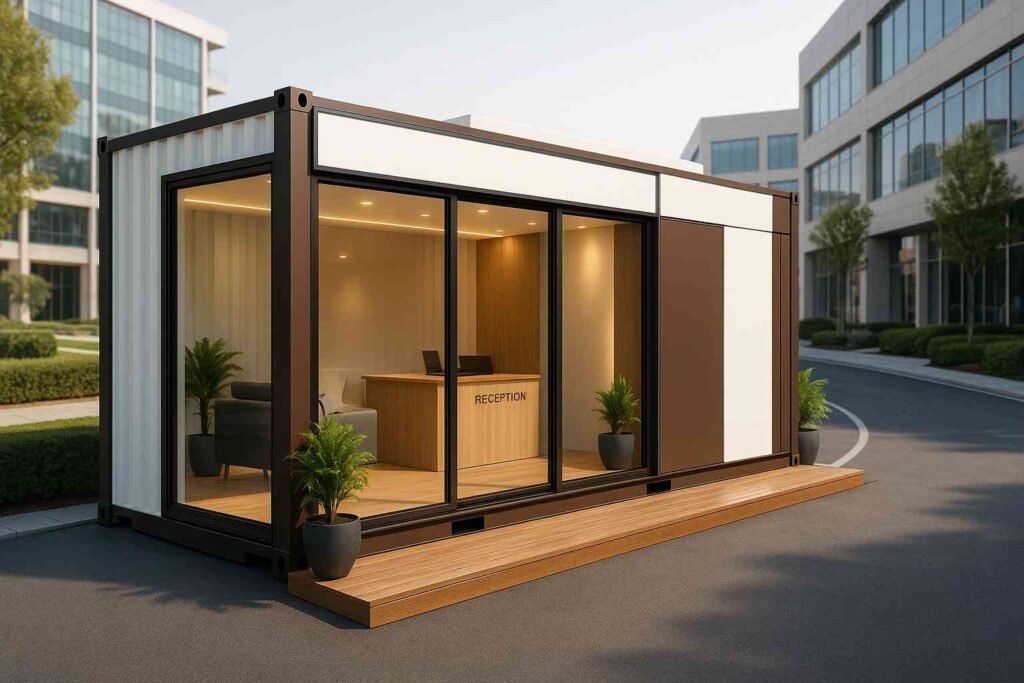
Global vs Indian Trends in Container Office Design
The global container office market is projected to grow at over 7% CAGR until 2033, driven by smart offices, luxury branding, and sustainable practices. India’s market is expanding even faster, fueled by smart city projects and infrastructure development. While global markets lead in technology integration, India focuses on cost efficiency and branded modular container offices.
Corporate: Indian corporates in Gurugram and Bengaluru prefer modular container offices with branding and IoT systems. Globally, corporates in Singapore and London use luxury container office design with glass façades and smart automation.
Real Estate: In India, developers in Mumbai deploy branded modular container offices as sales suites to boost trust. Globally, U.S. firms use modern container offices as real estate showrooms.
Education: NGOs in Himachal Pradesh use insulated modular container offices as rural classrooms. In Europe, modular container complexes serve as temporary school campuses during renovations.
Healthcare: Indian examples include Rajasthan’s mobile clinics using expandable container offices. Globally, African NGOs deploy solar-powered container clinics with HVAC to reach rural populations.
Events: Indian trade fairs in Chennai use modular container offices as reception centers and Wi-Fi hubs. Globally, Dubai Expo 2020 used luxury container offices as command centers, later repurposed as showrooms.
IT: Bengaluru startups rely on smart container office design with biometric entry and Wi-Fi boosters. In Silicon Valley, modern modular offices act as temporary innovation labs.
Mining: Australian mining firms deploy insulated container offices as labs. In Jharkhand, India, modular container offices act as worker safety hubs in coal fields.
Global Trends in Container Office Design
| Trend | India | Global |
| Luxury Container Office | Branded sales suites in Mumbai. | Executive offices in London, Singapore. |
| Smart Container Office | IoT-enabled hubs in Gurugram. | AI-driven HVAC in Singapore, U.S. biometric hubs. |
| Modular Complexes | Construction site offices in Delhi NCR. | Co-working villages in Europe, New York. |
| Eco-Friendly Design | Solar-powered IT offices in Pune. | Vertical gardens and green roofs in Germany, Singapore. |
This table compares Indian and global container office design trends. India emphasizes affordability and branding, while global markets push luxury and smart innovations.
Sustainability and ROI in Container Office Design
Sustainability is core to container office design. Each reused container saves ~2.5 tons of steel. Quality insulation trims HVAC loads by 20–30%. Solar, rainwater systems, and vertical gardens cut operating costs and elevate green credentials at resale.
Case Study India: A Pune IT company invested ₹50 lakh in solar-powered modular container offices with rainwater harvesting. They reduced electricity bills by 30% annually and recovered costs within five years through savings and resale.
Case Study Global: A German logistics company installed modular container offices with green roofs and advanced insulation. They achieved LEED Platinum certification, cut energy use by 40%, and gained new eco-conscious clients.
ROI Impact: Sustainable features increase resale recovery by 15–20%. Branded eco-friendly offices attract premium buyers, making green practices both financially and environmentally rewarding.
Sustainability Features and ROI Impact
| Feature | Benefit | ROI Impact |
| Solar Panels | Generates renewable energy. | Cuts energy bills by 20–40%. |
| PUF Insulation | Reduces thermal load. | Lowers HVAC costs over lifecycle. |
| Vertical Gardens | Improves insulation, branding. | Reduces cooling bills, boosts sales. |
| Rainwater Harvesting | Recycles water supply. | Cuts water bills, supports green certification. |
| LED & Smart Lighting | Automates energy use. | Saves 10–15% on power costs. |
This table proves that sustainability is financially smart. Green practices reduce costs, improve ROI, and strengthen branding in both modular and luxury container office design.
Future Outlook of Container Office Design
The future of container office design is shaped by technology, sustainability, and stricter regulations. Emerging technologies like AI, AR/VR, and IoT will dominate the next decade. Sustainability features will become mandatory as governments enforce green building standards.
AI & AR/VR: AI will optimize layouts for light and airflow. AR/VR will allow clients to walk through container office interiors before construction. Smart Cities: Container offices will connect with urban IoT grids, enabling real-time energy monitoring and predictive maintenance. Green Regulations: Countries are moving toward mandatory renewable energy integration. In India, state policies already incentivize solar-powered modular offices.
Market Outlook: Analysts predict the global container office design market will exceed $70 billion by 2035. India’s demand will surge in construction, IT, and real estate. With strong growth, container office design will be the backbone of future urban workspaces.
Key takeaways
• Container office design compresses timelines and CAPEX.
• Layouts and interiors drive comfort, brand, and ROI.
• Early approvals and accurate MEP save rework later.
FAQs on Container Office Design
What is container office design and why is it popular?
Container office design is the process of converting shipping containers into workspaces. It is popular because it is fast, affordable, sustainable, and adaptable compared to traditional offices.
How much does a modular container office cost in India?
A basic 20ft modular container office costs around ₹2–3 lakh. Luxury container office designs with branding and interiors can cost ₹12–15 lakh. This is far cheaper than permanent buildings, which often exceed ₹40 lakh.
What are the sustainability benefits of container office design?
Reused steel reduces waste, insulation cuts HVAC use by 20–30%, and solar panels lower electricity bills. These eco-friendly features reduce operating costs and support green certifications.
Can luxury container office design improve branding?
Yes. Real estate developers in Mumbai and Bengaluru use branded luxury container offices as sales suites. The professional look builds trust and improves sales conversions.
What is the future of smart container office design?
Smart container offices will use AI for layouts, AR/VR for previews, and IoT for real-time energy management. They will also integrate with smart city infrastructure and adopt renewable energy mandates.
Are container offices suitable for industries like healthcare or education?
Yes. In Rajasthan, expandable container clinics provide healthcare in rural areas. In Himachal Pradesh, modular classrooms are used by NGOs. Globally, container offices are used for co-working, mining labs, and event headquarters.
Conclusion: The Global Future of Container Office Design
Block 5 shows that container office design is central to the future of work. Global and Indian trends prove its adaptability. Sustainability features increase ROI while lowering environmental impact. Future scenarios highlight how AI, IoT, and stricter green codes will redefine modular and modern container offices. With clear cost benefits and branding power, container office design is a long-term solution for businesses worldwide.
https://www.grandviewresearch.com/industry-analysis/modular-construction-market














